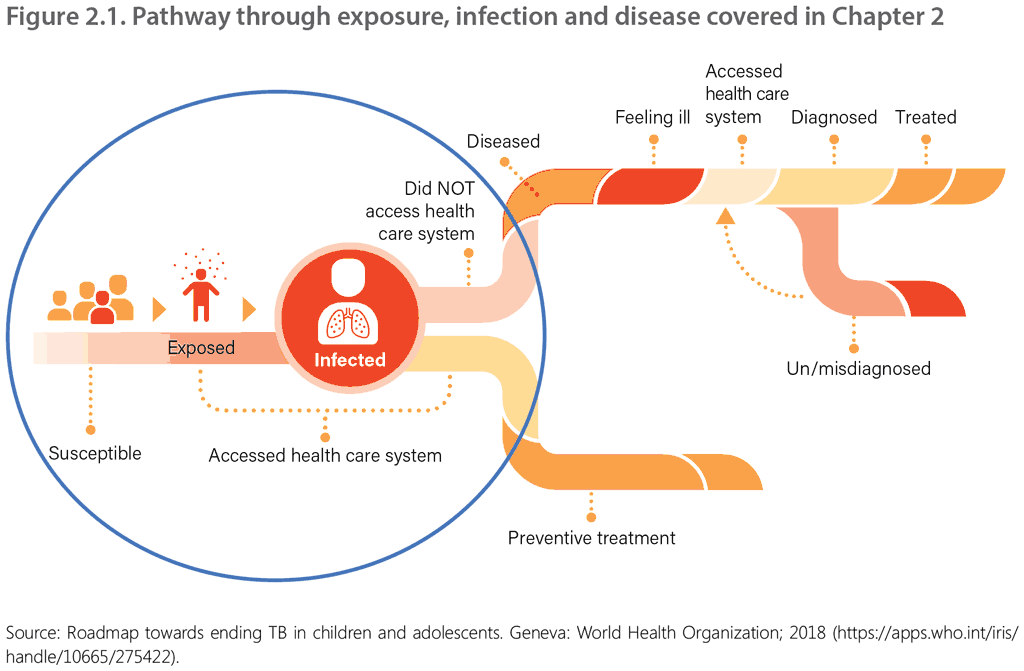Links de passagem do livro para 2.1 Introduction
About a quarter of the world’s population has been infected with Mycobacterium tuberculosis. The vast majority of these people do not have TB disease (10). It is estimated that 7.5 million children and young adolescents aged under 15 years are newly infected with M. tuberculosis each year (11). Cumulatively, about 67 million children and young adolescents aged under 15 years are infected with M. tuberculosis, including 2 million with MDR-TB and 100 000 with extensively drug-resistant tuberculosis (XDR-TB) strains, and therefore at risk of developing TB disease (12). The risk of infection is greatest if exposure to a person with TB disease is close and prolonged (e.g. exposure of an infant or toddler to the mother or other caregiver in the household) (6).
Contact investigation is the systematic identification of people, including children and adolescents, with previously undiagnosed TB disease and TB infection among the contacts of a TB patient. TB exposure usually follows household or other close contact with a person (usually an adolescent or adult) with bacteriologically confirmed PTB. Contact investigation and management consist of identification of close contacts, clinical evaluation, testing (where possible), and provision of appropriate TB treatment (for people with TB disease) or TPT (for people without TB disease but with proven or suspected TB infection) (13).
If the index case is a child, it is recommended that contact investigation and screening include efforts to identify the likely source of infection. This is known as “reverse contact investigation” or “source case investigation” (6). The terms “contact investigation” and “contact evaluation” are often used synonymously with “contact tracing”. In the context of TB, however, action beyond identifying contacts is critical (13), and this handbook uses the term “contact investigation”.
Implementation of effective algorithms for TB screening and provision of TPT or disease treatment, as appropriate, can improve the health of exposed individuals and the community in general (13).
Systematic screening for TB disease is the systematic identification of people at risk for TB disease, in a predetermined target group, by assessing symptoms and using tests, examinations or other procedures that can be applied rapidly. In people who screen positive, the diagnosis needs to be established by one or several diagnostic tests and additional clinical assessments (see Chapter 4). The term “systematic screening for TB disease” is sometimes used interchangeably with “active TB casefinding” (14). The aim is to detect TB disease early in order to minimize delays in treatment initiation,
thereby reducing health sequelae for the patient, ongoing TB transmission within the community, and adverse social and economic consequences of TB for individuals and their families. Contact investigation is therefore a form of systematic screening for TB, but it also includes identification of (likely) TB infection and provision of TPT.
Early diagnosis of TB, including universal drug susceptibility testing (DST), systematic screening of contacts and high-risk groups, and preventive treatment of people at high risk for TB disease, are key components of Pillar 1 (integrated patient-centred care and prevention) of the WHO End TB Strategy (7). Detecting TB only among people who present to health facilities is not enough to find all people with TB disease. The remaining case detection gap (particularly in children and adolescents), persistence of diagnostic delays resulting in morbidity and mortality, and continued transmission in the community indicate the need for a more active approach to the early detection of TB. This justifies systematic screening of selected risk groups and populations for TB disease (5, 13).
This chapter relates to the section of the pathway highlighted in blue in Figure 2.1. It provides implementation guidance on WHO recommendations on TB contact investigation and screening that apply to children and adolescents. It also provides some examples of successful approaches.

 Opinião
Opinião